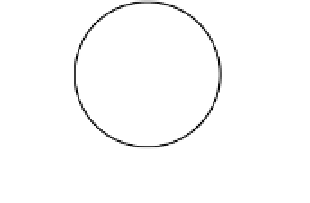Game Development Reference
In-Depth Information
ω
bo
v
bx
mg
F
f
= μmg
Figure 7-10.
The forces and velocities at the beginning of the skid phase
We want to determine the time it takes until the golf ball is rolling without skidding and the
distance it travels during that time. To determine these results, a process similar to the one
discussed in the “Collisions with Friction” section of Chapter 6 can be used. The angular velocity
of the ball at a given time is equal to the initial angular velocity plus the torque exerted on the
golf ball divided by the moment of inertia of the ball.
m
w
=+
mgr
t
I
(7.32)
b
0
The translational velocity of the golf ball at any point during the skid phase is equal to the
initial velocity plus the acceleration due to friction multiplied by the elapsed time. Friction
works to slow the ball down, so the acceleration is negative.
=−
vv
m
t
(7.33)
bx
Since we know that the point the ball begins to roll without skidding is when
v = r
w
, we
can use this fact along with Equations (7.32) and (7.33) to obtain an expression for the time that
this occurs.
(
)
2
vr
′ −
w
bx
b
0
t
=
(7.34)
7
g
Plugging this time value into Equations (7.32) and (7.33) results in the translational and
angular velocity at the point where the ball begins rolling without skidding.
5
2
′
v
=
v
+
rw
(7.35)
br
bx
b
0
7
7
′
==
v
v
5
2
br
bx
w
+
w
(7.36)
br
b
0
r
7
r
7
Once again, we get the interesting result that the velocities of the ball when it begins to roll
without sliding are independent of the coefficient of friction between the ball and green. The
distance traveled during the skid phase can be computed from the standard expression relating
distance, velocity, and acceleration.
1
2
xvt
′=−
m
t
2
(7.37)
bx









